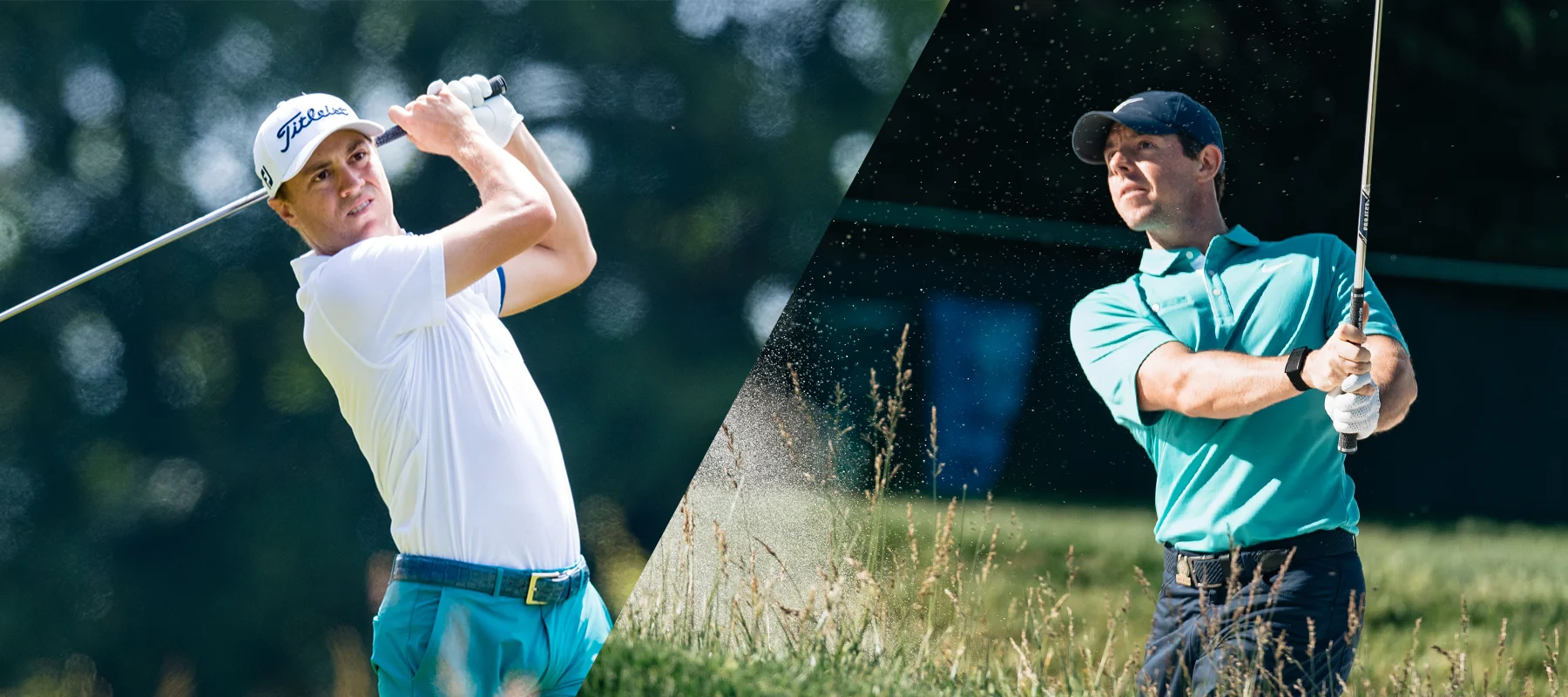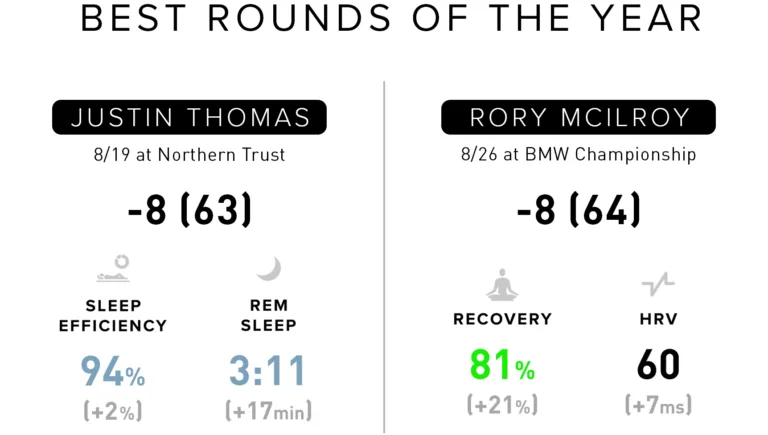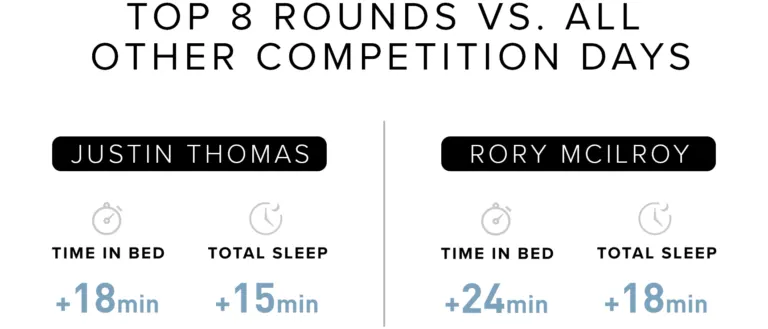Topics
- Article
- Golf
- Member Stories
Insights from Justin Thomas & Rory McIlroy’s WHOOP Data Prior to Ryder Cup

We take a look at highlights from Justin Thomas and Rory McIlroy to close out the 2021 golf season and examine correlations in their WHOOP data. Plus, what do their strain, sleep, recovery and heart rate look like heading into the Ryder Cup?
Including the Masters last November, the Olympics this past summer, and the upcoming Ryder Cup September 24-26, the past 12 months of professional golf were a “super season” packed full of every big event imaginable. With a Players Championship win for Justin Thomas and a Wells Fargo Championship victory for Rory McIlroy, it’s been quite the year for two prominent WHOOP athletes. As they prepare to square off against each other in the 2021 Ryder Cup at Whistling Straits, we took a look at Justin and Rory’s WHOOP data from the final six tournaments of the season--a particularly grueling stretch of golf that included the Open Championship, the Olympics, and the FedEx Cup Playoffs. To no surprise, some of their top performances on the golf course correlated with several highlights in their WHOOP metrics. And with all eyes on the showdown ahead, we also studied recent data from both Justin and Rory during their off weeks prior to the Ryder Cup this weekend.
Individual Highlights & WHOOP Metrics
We examined the eight best rounds Justin and Rory each played spanning the last six tournaments of the season, as well as their average WHOOP data from those days compared to all other days of competition in that time period. Here are some of the highlights:
- Saturday 7/17 at the Open Championships: Rory shot a 1-under-par 69 following his most time spent in bed (9.2 hours) between the end of June and now.
- Sunday 8/1, Olympics final round: Justin shot a 6-under-par 65. His heart rate variability (HRV) was 59 ms, significantly above his average of 49 across other competition days. Additionally, his resting heart rate (RHR) was 53 bpm compared to an average of 56. As to be expected, Justin’s recovery was in the green (77%).
- Thursday 8/5, Day 1 of WGC-FedEx St. Jude Invitational: Justin was 3 under par (67) after sleeping for 9.3 hours, his longest night’s sleep of July and August.
- Sunday 8/8, last day of WGC-FedEx: Rory shot a 4-under 66 following 7.6 hours of sleep, a full hour more than his competition average of 6.6 hours.
- Thursday 8/19, Northern Trust Day 1: This was Justin’s best round of the year, a -8 (63). He had 94% sleep efficiency (vs a competition average of 92%) that included an impressive 3.19 hours of restorative REM sleep (17 minutes more than usual).
- Thursday 8/26, BMW Championship Day 1: Rory’s best round of the year was also a -8 (64). He had an outstanding 81% recovery that morning with an elevated HRV of 60 (7 ms above his norm during tournaments).

Justin Thomas and Rory McIlroy had stellar WHOOP stats prior to their lowest scores of the season.
Better Sleep, Better Play
Breaking down the average WHOOP data for Justin and Rory from their top eight rounds compared to all other tournament days, there was one fairly consistent finding that emerged: For each of them, better sleep often led to better outcomes on the course. Both Justin and Rory averaged more time in bed and more time asleep prior to their best rounds than they did for other days of play.

Justin Thomas and Rory McIlroy each Averaged more sleep before their best rounds than they did for other days of competition.
Green Recovery, High HRV & Low Golf Scores
With Rory specifically, we also discovered a distinct connection between his lowest golf scores and his highest WHOOP recoveries and HRV. His average recovery improved from 60% to 67% on the days he played his best, while his average HRV increased from 53 to 56. Also worth noting is the fact that for both Justin and Rory, their highest average recoveries during tournaments came on Sundays. Considering that for many golfers the strain of tournament play generally takes its toll as the weekend progresses, this is a testament to each of their abilities to manage workload and have their bodies ready to peak when it matters most.
Rested, Primed and Prepared for Ryder Cup
Since the conclusion of the Tour Championship on September 5, both golfers have had some time to “rest” and get themselves prepared for the Ryder Cup. Over the past two weeks, there are a number of potential indicators in Justin and Rory’s data that they may each be primed and ready to go on Friday. In the past 10 days, Justin has recorded his best recovery of the year (99%), as well as his longest sleep (9.3 hours) and time spent in bed (10.8 hours). Similarly, over that same span Rory has also logged his lowest RHR (46) and most efficient sleep (96%) of the season.

Justin Thomas and Rory McIlroy posted great WHOOP metrics heading into the Ryder Cup.
Justin is getting higher quality sleep lately as well. He’s averaging 2 hours of deep sleep per night compared to 1.8 in the month of August, and his nightly percentages of restorative sleep have gone up too (REM from 34% to 39%, and deep sleep from 23% to 31%). For Rory, in addition to averaging more sleep (7.6 hours per night vs 6.7 in August), his daily recovery (from 65% to 68%) and HRV (55 to 57) are also on the rise. Plus, Rory has drastically reduced his average day strain (from 13.3 to 8.6), a great sign that he’ll be firing on all cylinders this weekend.